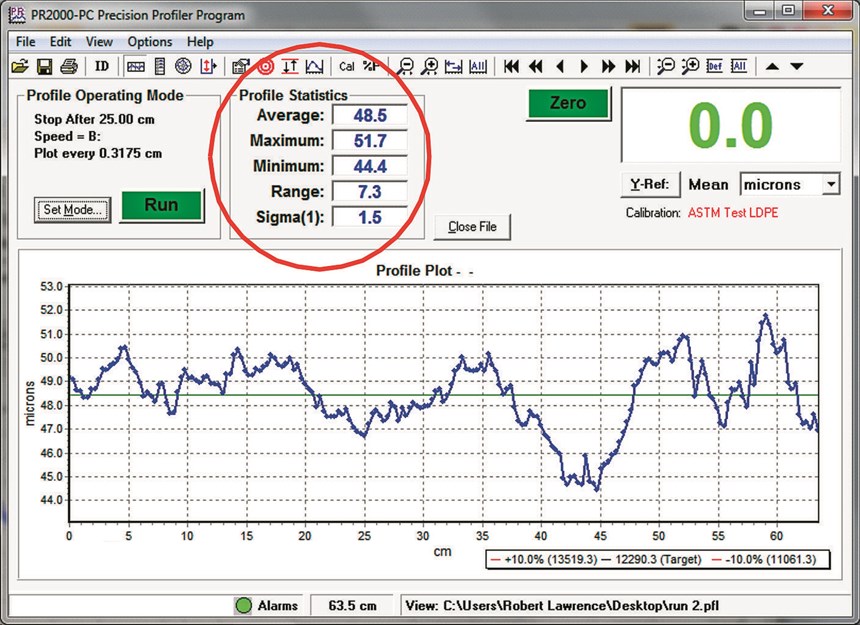New ASTM Standard on Thickness Measuring to Boost Film Quality
Non-contact measurement standard should also expedite the testing process.
A new ASTM International standard will give processors a better test method for measuring the average thickness and thickness variability of film, and will likely result in an improvement in quality across the board. So says ASTM International member Rob Lawrence, a mechanical engineer at SolveTech Inc.., Wilmington, Del., which makes capacitance-based, non-contact gauging equipment. The standard (D8136) was developed by ASTM International’s committee on plastics (D20).
“The new test method is more accurate, precise, and easier to use than existing test methods,” says Lawrence. “The standard will help almost the entire chain in the film industry, and it will likely improve quality throughout the industry.”
The new standard defines film thickness using a NIST (National Institute of Standards and Technology) traceable calibration.
It also defines profiling, which is used to determine a film sample’s variability and average thickness. According to Lawrence, this approach eliminates many of the problems that resulted from the former standard, which relied on gauging technology that contacted the film. For example, he notes that deformations, dust, and dirt on film samples using contact gauges can skew the readings, and data gathering tends to be slow and laborious. With the new standard, he says, film users can accurately profile a film sample in 30 to 60 sec. (see photo).
A $200,000 PROBLEM
Lawrence reports that an undisclosed film processor that had already adopted the new standard solved “a $200,000 problem.” Due to disputes regarding film thickness, the processor’s bag-maker customer was rejecting about 10% to 15% of film shipments.
Question about film extrusion? Visit the Extrusion Zone.
Over a six-month period, the issue had cost the converter approximately $100,000, and the film producer $15,000 to $20,000 per month. Says Lawrence, “Both the supplier and the converter had SolveTech Profilers to measure film thickness and variability. Film variability was important to the converter as it saw issues with film sealing, and bags that had high variability were also failing tests when they loaded the bags with 30 lb.
“To solve the problem, I utilized the methods in the new ASTM standard, Lawrence continues. “I requested samples of the material, calibrated an instrument at SolveTech using their material, and then created calibration frames, which are used as a calibration reference. This calibration of the instrument used the NIST-traceable calibration. Using the calibration frames, the buyer and the seller matched their Precision Profilers to each other so there was no longer a discrepancy. Along with the instruments matching each other, they also were accurately calibrated to the correct answer according to gauge by weight.
Using the new standard greatly improved relations between one film supplier and a converter customer, cutting rejects dramatically.
Now the supplier checks the material while he is producing it and before it ever leaves his site. When the converter receives it, they check it as well and get the same answer.
“One year later, the relationship between the film supplier and converter has never been better. Rejections have been reduced from 10-15% to 0.5%, resulting in a huge cost savings as well as making both operations run smoothly,” Lawrence notes, adding that the bag maker plans on requesting that all of its suppliers comply with the new ASTM standard once it is in place, since it has been such a help to its operation.
Related Content
Upgrade to Accelerated Artificial and Natural Weathering Testing
NPE 2024: Atlas’ S³T system is designed for the company’s Weather-Ometer Ci4400 and Ci5000 instruments
Read MoreHeight Gauge With Added Features and Accuracy
NPE2024: Mitutoyo America’s LH600F features a touchscreen interface that enables easy and intuitive operation.
Read MoreUpgrade to Accelerated Artificial and Natural Weathering Testing
NPE2024: Atlas S³T system is designed for the company’s Weather-Ometer Ci4400 and Ci5000 instruments.
Read MoreDatacolor Acquires Matchmycolor
The acquisition of the specialist in color formulation and communication software further expands Datacolor’s global industry presence in color management.
Read MoreRead Next
People 4.0 – How to Get Buy-In from Your Staff for Industry 4.0 Systems
Implementing a production monitoring system as the foundation of a ‘smart factory’ is about integrating people with new technology as much as it is about integrating machines and computers. Here are tips from a company that has gone through the process.
Read MoreLead the Conversation, Change the Conversation
Coverage of single-use plastics can be both misleading and demoralizing. Here are 10 tips for changing the perception of the plastics industry at your company and in your community.
Read MoreMaking the Circular Economy a Reality
Driven by brand owner demands and new worldwide legislation, the entire supply chain is working toward the shift to circularity, with some evidence the circular economy has already begun.
Read More

























